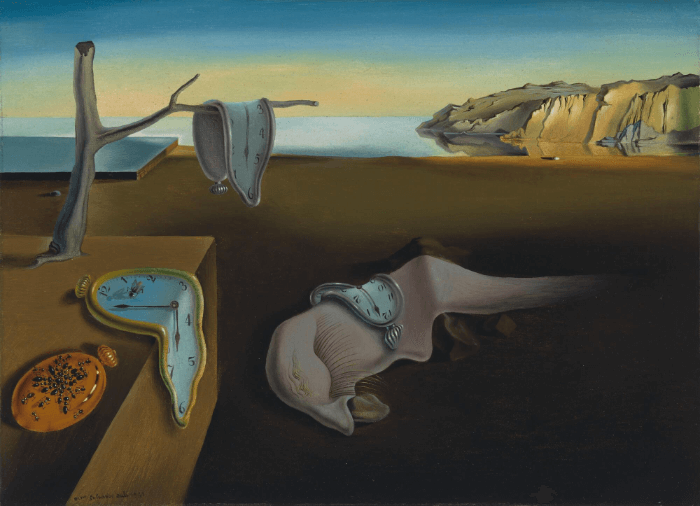This post is part of a larger deep dive
Curious about the role of the illusion of time in The Persistence of Memory? Check out The Persistence of Memory Explained!
Or read the full The Persistence of Memory article!
This post is part of a larger deep dive
Curious about the role of the illusion of time in The Persistence of Memory? Check out The Persistence of Memory Explained!
Or read the full The Persistence of Memory article!
Artist: Salvador Dalí
Year: 1931
Medium: Oil on canvas
Location: Museum of Modern Art (MoMA), New York City, U.S.A.
Dimensions: 24 cm × 33 cm (9.5 in × 13 in)
Original Title: La persistencia de la memoria

Our rating

Your rating
I recently went to New York City for the very first time, and what an amazing experience that was!
Broadway for fantastic shows, Comedy Cellar for having a laugh, Central park for a joyful stroll, The Rock for amazing views, Liberty Island/Ellis Island for history… There is everything for everyone!
Being an art lover, I also couldn’t miss the opportunity to visit one of the most famous museums in the world: the Museum of Modern Art. I spent about 4 hours just on the 5th floor – it is packed with world-renown paintings from Vincent Van Gogh, Pablo Picasso, Rene Magritte, Max Ernst, Henri Matisse and many more.
If you have read some of my previous Art articles, you should know by now that I’m a huge fan of Dali’s works. Fortunately, Dali has a tiny presence in that museum as well. Well, tiny in size perhaps, because it is arguably the most famous of all surrealistic paintings: The Persistence of Memory.
It wasn’t hard to find the room where the painting was located. Setting aside the Starry Night by Vicent Van Gogh, the Persistence of Memory is probably the most famous painting in MoMa. Crowds of visitors enveloped the painting, making selfies with the painting (?), so I decided to wait until about an hour before MoMa closed and crowds dispersed to be able to examine this painting with care. I was surprised to find that the painting has unremarkable dimensions: it is only 24 cm (9.5 in) x 33 cm (13 in), about the size of the surface of a shoebox.
But what it lacks in size it makes up in detail.
The main motif of the painting is the melting clocks, which appear to have been based on Dali’s dreams. One red clock is actually not melting but rather being devoured by a colony of hungry ants. The mastery with which Dali painted the melting of the clocks really give it dynamism, as though we are able to visualise the clocks dripping.
The background desolated landscape contains some cliffs which are reminiscent of the rugged cliffs of Catalonia, Dali’s birthplace. The sunny weather and desert-like surface adds to the impression of the clocks melting in the torrid and scorching heat. Carefully examination reveals exquisite details of the cliffs, with different shades of yellow and superb reflections on the sea.
At the center we see an amorphous figure with eyes closed. Some have suggested it is a monster, some believe it is a human, others suggest that is Dali himself… dreaming.
The perspective of the monster is slightly awkward, although probably intentional. Its tail blends in with the terrain, perhaps to symbolize the ethereal world of dreams.
Being a huge fan of Dali, there is probably no painting of his that I dislike. The Persistence of Memory, however, doesn’t rank among my favourites. It’s certainly interesting, but I find some of the elements a bit weirdly placed. In my opinion, there are certainly paintings Dali which are much more infused with symbolism than the Persistence of Memory.
Of course, I cannot rule out that my feelings towards this painting may have been biased by the huge popularity it enjoys, with a somewhat overused presence in surrealistic conversations.
Here at Mindlybiz, The Persistence of Memory gets 3.5 stars.
Well, what do you expect from a Dali painting? Bizarre is surely a prerequisite. And The Persistence of Memory doesn’t disappoint. Dali included some clues in this painting that allows us to decipher its meaning, so even though bizarre it isn’t his most cryptic work.
The Persistence of Memory receives a bizarrometer score of 4.

In my view, all elements in The Persistence of Memory are intricately tied to the theme of time in one way or another.
The melting clocks might symbolise the malleability and subjective nature of time, as well as Dali’s rejection of the notion that time flows linearly, aligning with philosophical ideas that time’s passage is an illusion shaped by human perception. The clocks’ melting appearance may also reflect entropy increases, leading to irreversible disorder.
The metallic watch swarmed by ants further supports the theme of decay and the inevitability of entropy. Ants, drawn to organic decay, serve as a metaphor for the gradual breakdown of all systems in the universe, driven by the thermodynamic and cosmological arrows of time. Similarly, the central disfigured figure, often thought to represent Dalí himself, portrays the inescapable effects of entropy on human life. Over time, even our highly organised bodies succumb to disintegration, reinforcing the inevitability of decay and death.
The barren landscape intensifies this theme, presenting a world where time appears frozen and devoid of life. The lifeless tree, barren terrain, and silent sky evoke a sense of timeless desolation, where entropy has culminated in complete stillness. Other symbolic elements, such as the fly on the melting clock, the mirror, and the egg, deepen the painting’s exploration of time.
Finally, time in dreams and past memories is often distorted, with durations feeling either compressed or elongated compared to reality. Dalí may be hinting that our experience of time—whether in waking life, dreams, or memory—is illusory and shaped by our psychological perception.
Ultimately, The Persistence of Memory masterfully weaves symbols of entropy, decay, and subjective time, inviting viewers to reflect on the malleable and transient nature of existence.
Let’s explore these points in detail, after learning some interesting ideas about the meaning of time.
Masterpiece
I must say you are the most creative reviewer of film and art I have read, I never would have connected Dali’s painting with the Second Law of Thermodynamics. Good Job!
To be honest, I realized that the painting had something to do with time, and I sensed the message also had something to do with dying, but I would not have been cleaver enough to bring in entropy. Nonetheless, your explanation does make sense.
Hi David,
Wow, many thanks for the compliment!
To be fair though, the ideas I put forth in my articles have been, in some form or another, already touched upon out there. I simply expand on these ideas and maybe add a slight personal touch 😉
But, really, many thanks for the comment – it’s comments like yours that give me the motivation to keep writing articles like these 😀